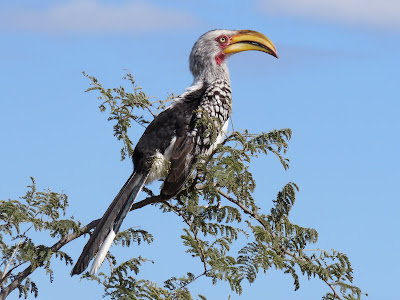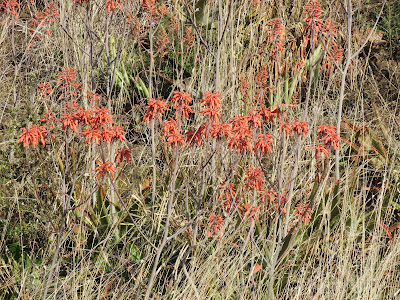Well here we are in Kruger for a final time this leg and starting with one of the unfortunately, increasingly rare sightings of a raptor - and if they are rare here, imagine what it's like elsewhere. Being winter this brown eagle is fairly easily identified as a Tawny because all the confusingly similar species have departed to supposedly fairer climes to the north.
Apologies for the haze but could only get this shot through the windscreen. Most will recognize this a a Hamerkop nest but it is interesting for several reasons. Firstly its size. A tree which contained a nest in the grounds of Pretoria zoo was blown over many years a go and the erstwhile staff were able to weigh the material that made up the structure, which was just over 300 kg. This example was (as with most nests) at least a metre from base to roof and contains a side tunnel which gives access to the mud-lined hollow chamber concealed in it's bowels. The chamber is constructed as material is being built up around and eventually over it. The top story is frequently annexed by Egyptian geese and bees have been known to take over the chamber. All this from a couple of birds that weigh about half a kilogram.
A little further along at the Biyamithi weir, a pair of woolly-necked storks were busily preening themselves and each other, while......
........on the other side of the river a southern yellow-billed hornbill had just finished uttering it's wuk,wuk,wuk call and was looking rather pleased with itself.
The beauty of Kruger is that you never know what's going to happen next. My camera is not capable of capturing shots of the amazing colours exhibited on the wings of a lilac-breasted roller as it swoops down to nab prey, so I had to be satisfied with the end result.
Lunch was enjoyed at Skukuza, looking out on the Crocodile River towards the old railway bridge. Apparently there are plans to refurbish some old sleeper coaches and park them on the bridge for a different over-night experience.
Heading towards Phabeni gate I noticed this lady making her way across the road behind me and found a novel use for the wing mirror.
I actually missed the turn-off to Phabeni and ended up at Paul Kruger Gate so turned around in in one of those sublimely serendipitous moments found this little lady not more than half a kilometer away. May be mistaken, but assumed a she, based purely on size, not that it matters with such a stunning animal.
There was some sort of scent that caught her attention and she spent quite a while sniffing around until some imbecile pulled up right next to her for a selfie and she was gone in a flash. People!
Shitlhave Dam on the way to the gate had it's fair share of interest in the form a graceful black stork also putting recalcitrant feathers to rights....
.....a massive herd of buffalo wallowing and drinking....
....and ox-pecker encrusted hippo that had decided that the water was a touch too nippy.
As friends had requested a house-sitter in Kloof, the Beast and I headed for Bonamanzi for a few nights before the trek to Durban. On settling into my favourite campsite I noticed that the surrounding forest was awash with butterflies which I eventually identified as African common whites. (Feel free to correct me Steve - I used your book!)
Seems they just had one thing in mind! Talk about Fly United.
Took a stroll one morning in an area I hadn't been in before and came across this very interesting tree which I didn't recognize and failed miserably to key out. Resolving to ask Richard Boon I took pictures......
......particularly of the very unusual bark, which appeared to be covered with lichen. Happened to have dinner with the guru who was visiting from Oz and was informed that this is a new species of Berchemia which had been wrongly identified as Brown Ivory in the first edition of Trees of KZN. He is currently working with Braam van Wyk on describing the species - may soon have a B. boonii.
.....while the roadside was liberally sprinkled with common soap aloe A. maculata.
Arriving in Kloof it was almost compulsory to take the path from the Turner's garden down the the edge of Molweni Gorge and sit for a while navel-gazing in the sun.
Directly opposite, the Uve Falls drop about 30 m before linking up with the Molweni River.
Returning I found this Blue spikethorn in copious flower. Had to do some digging as it has had a couple of name changes and is now known as Gymnosporia glaucophylla - quite a mouthful!
Dainty little flowers though.
At last a butterfly that actually remained stationary for more than a millisecond, but then the commodors are normally quite obliging, this being the garden variety.
It's not often one sees a sunset from this part of Forest Hills so felt obliged to take this on my way out one evening.
As Krantzkloof Reserve covers around 560 ha a couple of visits are required, this time to the Uve Road section immediately above the falls shown previously.
Here a number of Indian hemp-leaved hibiscus H. cannabinus (unsurprisingly) were in flower and don't bother smoking the leaves they just look like the real thing.
Another of my favourites, Traveller's joy Clematis braciata with its fluffy seed pods glowing in the early sunlight......
............and a final look back along this magnificent geological feature and while writing this a dozen or more vervet monkeys are wreaking havoc my caravan awning which they have turned into a trampoline.




























